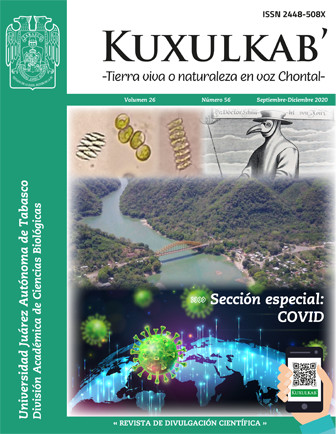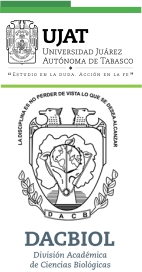¿CUÁL ES EL MECANISMO QUE PERMITE AL SARS-CoV-2 ENTRAR A LAS CÉLULAS HUMANAS?
DOI:
https://doi.org/10.19136/kuxulkab.a26n56.3838Palabras clave:
Coronavinidae, COVID-19, CoronavirusResumen
El SARS-CoV-2, un nuevo virus perteneciente a la familia Coronaviridae, es el causante de un nuevo tipo de neumonía (COVID-19) la cual se detectó por primera vez en diciembre de 2019 en la ciudad de Wuhan, Hubei. Gran parte de las personas infectadas en un inicio con este virus fueron trabajadores y consumidores del mercado de animales y peces de esa ciudad. El SARS-CoV-2 se ha diseminado rápidamente alrededor del mundo provocando más de 2.5 millones de personas contagiadas y más de 180 mil defunciones a causa de contagio.
Descargas
Referencias
Anastasopoulou, S. & Mouzaki A. (2020). The biology of SARS-CoV-2 and the ensuing COVID-19. ACHAIKI IATRIKI, 39(1): 29-35. Recovered from «http://www.iedep.gr/images/stories/teuxi/issue39_1/06_Anastasopoulou.pdf»
Chan, J.F.-W.; Kok, K.-H.; Zhu, Z.; Chu, H.; To, K. K.-W.; Yuan, S.; & Yuen, K.-Y. (2020). Genomic characterization of the 2019 novel human-pathogenic coronavirus isolated from a patient with atypical pneumonia after visiting Wuhan. Emerging Microbes & Infections, 9(1): 221-236. DOI «https://doi.org/10.1080/22221751.2020.1719902»
Coutard, B.; Valle, C.; de Lamballerie, X.; Canard, B.; Seidah, N.G. & Decroly, E. (2020). The spike glycoprotein of the new coronavirus 2019-nCoV contains a furin-like cleavage site absent in CoV of the same clade. Antiviral Research, 176: 104742. DOI «https://doi.org/10.1016/j.antiviral.2020.104742»
Elshabrawy, H.A.; Coughlin, M.M.; Baker, S.C.; & Prabhakar, B.S. (2012). Human monoclonal antibodies against highly conserved HR1 and HR2 domains of the SARS-CoV spike protein are more broadly neutralizing. PLoS ONE, 7(11): e50366. DOI «https://doi.org/10.1371/journal.pone.0050366»
Fehr, A.R. & Perlman, S. (2015). Coronaviruses: an overview of their replication and pathogenesis. In: Maier H., Bickerton E., Britton P. (eds); Coronaviruses: methods in molecular biology, (Vol 1282; pp. 1-23). New York, NY; USA: Humana Press. Recovered from «https://doi.org/10.1007/978-1-4939-2438-7_1»
Fung, T.S. & Liu, D.X. (2014). Coronavirus infection, ER stress, apoptosis and innate immunity. Frontiers in Microbiology: virology, 5: 1-13. DOI «https://doi.org/10.3389/fmicb.2014.00296»
Gorbalenya, A.E.; Baker, S.C., Baric, R.S.; de Groot, R.J.; Drosten, C.; Gulyaeva, A.A.; Haagmans, B.L.; Lauber, C.; Leontovich, A.M.; Neuman, B.W.; Penzar, D.; Perlman, S.; Poon, L.L.M.; Samborskiy, D.V.; Sidorov, I.A.; Sola, I. & Ziebuhr, J. (2020). The species Severe acute respiratory syndrome-related coronavirus: classifying 2019-nCoV and naming it SARS-CoV-2. Nature Microbiology, 5(4): 536-544. DOI «https://doi.org/10.1038/s41564-020-0695-z»
Helmy, Y.A.; Fawzy, M.; Elaswad, A.; Sobieh, A.; Kenney, S.P. & Shehata, A.A. (2020). The COVID-19 pandemic: a comprehensive review of taxonomy, genetics, epidemiology, diagnosis, treatment, and control. Journal of Clinical Medicine, 9(4): 1225. DOI «https://doi.org/10.3390/jcm9041225»
Khailany, R.A.; Safdar, M. & Ozaslan, M. (2020). Genomic characterization of a novel SARS-CoV-2. Gene Reports, 19: 100682. DOI «https://doi.org/10.1016/j.genrep.2020.100682»
Kuhn, J.H.; Li, W.; Choe, H. & Farzan, M. (2004). What's new in the renin-angiotensin system?, Angiotensin-converting enzyme 2: a functional receptor for SARS coronavirus. Cellular and Molecular Life Sciences, 61(21): 2738-2743. DOI «https://doi.org/10.1007/s00018-004-4242-5»
Liu, W. & Li, H. (2020). COVID-19: attacks the 1-beta chain of hemoglobin and captures the porphyrin to inhibit human heme metabolism. ChemRxiv, Preprint (revised on, 10(04). DOI «https://doi.org/10.26434/chemrxiv.11938173.v9»
López-Goñi, I. (2020, enero 10). La historia se repite: ¿un nuevo coronavirus en China?. El rincón de Pasteur, Investigación y Ciencia [Web]. Consultado en «https://www.investigacionyciencia.es/blogs/medicina-y-biologia/43/posts/la-historia-se-repite-un-nuevo-coronavirus-en-china-18220»
Maier, H.J.; Bickerton, E. & Britton, P. (2015). Coronaviruses: methods and protocols, (Methods in Molecular Biology; Vol. 1282). New York, NY; USA: Humana Press. DOI «https://doi.org/10.1007/978-1-4939-2438-7»
NIH (National Institutes of Health). (2016). Talking glossary of genetic terms. National Human Genome Research Institute NHGRI [Web]. Consulted in «https://www.genome.gov/genetics-glossary»
Phan, T. (2020). Genetic diversity and evolution of SARS-CoV-2. Infection, Genetics and Evolution, 81: 104260. DOI «https://doi.org/10.1016/j.meegid.2020.104260»
Shen, Z.; Xiao, Y.; Kang, L.; Ma, W.; Shi, L.; Zhang, L.; Zhou, Z.; Yang, J.; Zhong, J.; Yang, D.; Guo, L.; Zhang, G.; Li, H.; Xu, Y.; Chen, M.; Gao, Z.; Wang, J.; Ren, L. & Li, M. (2020). Genomic diversity of Severe Acute Respiratory Syndrome-Coronavirus 2 in patients with Coronavirus disease 2019. Clinical Infectious Diseases, 71(15): 713-720. DOI «https://doi.org/10.1093/cid/ciaa203»
Tang, X.; Wu, C.; Li, X.; Song, Y.; Yao, X.; Wu, X.; Duan, Y.; Zhang, H.; Wang, Y.; Qian, Z.; Cui, J. & Lu, J. (2020). On the origin and continuing evolution of SARS-CoV-2. National Science Review, 7(6): 1012-1023. DOI «https://doi.org/10.1093/nsr/nwaa036»
Tortorici, M.A. & Veesler, D. (2019). Chapter Four - Structural insights into coronavirus entry. In: Rey, F.A. (ed.); Advances in Virus Research, (Vol. 105; pp. 93-116). Academic Press. DOI «https://doi.org/10.1016/bs.aivir.2019.08.002»
Tortorici, M.A.; Walls, A.C.; Lang, Y.; Wang, C.; Li, Z.; Koerhuis, D.; Boons, G.-J.; Bosch, B.-J.; Rey, F.A.; de Groot, R.J. & Veesler, D. (2019). Structural basis for human coronavirus attachment to sialic acid receptors. Nature Structural & Molecular Biology, 26(6): 481-489. DOI «https://doi.org/10.1038/s41594-019-0233-y»
Walls, A.C.; Park, Y.-J.; Tortorici, M.A.; Wall, A.; McGuire, A.T. & Veesler, D. (2020). Structure, function, and antigenicity of the SARS-CoV-2 spike glycoprotein. Cell, 181(2): 281-292. DOI «https://doi.org/10.1016/j.cell.2020.02.058»
Wang, D.; Hu, B.; Hu, C.; Zhu, F.; Liu, X.; Zhang, J.; Wang, B.; Xiang, H.; Cheng, Z.; Xiong, Y.; Zhao, Y.; Li, Y.; Wang, X. & Peng, Z. (2020). Clinical characteristics of 138 hospitalized patients with 2019 novel coronavirus-infected pneumonia in Wuhan, China. Jama, 323(11): 1061-1069. DOI «https://doi.org/10.1001/jama.2020.1585»
Wrapp, D.; Wang, N.; Corbett, K.S.; Goldsmith, J.A.; Hsieh, C.-L.; Abiona, O.; Graham, B.S. & McLellan, J.S. (2020). Cryo-EM structure of the 2019-nCoV spike in the prefusion conformation. Science, 367(6483): 1260-1263. DOI «https://doi.org/10.1126/science.abb2507»
Zappala, C. (2020, April 24). The strain of SARS-COV-2, (p. 6). Australian Medical Association (AMA). Recovered from «https://ama.com.au/sites/default/files/AMA_PPE_Chris_Zappala_COVID_19_Strains.pdf»
Zhang, H.; Penninger, J.M.; Li, Y.; Zhong, N. & Slutsky, A.S. (2020). Angiotensin-converting enzyme 2 (ACE2) as a SARS-CoV-2 receptor: molecular mechanisms and potential therapeutic target. Intensive Care Medicine, 46(4): 586-590. DOI «https://doi.org/10.1007/s00134-020-05985-9»
Descargas
Publicado
Número
Sección
Licencia
Derechos de autor 2020 Kuxulkab

Esta obra está bajo una licencia internacional Creative Commons Atribución-NoComercial-CompartirIgual 4.0.
Los autores que publiquen en Kuxulkab' aceptan las siguientes condiciones como política de acceso abierto:
1. Que conservan los derechos de autor y ceden a la revista el derecho de la primera publicación, con el trabajo registrado con la licencia de atribucion de "Creative Commons", que permite a terceros utilizar lo publicado siempre que mencionen la autoría del trabajo y a la primera publicación en esta revista.
2. El autor puede realizar otros acuerdos contractuales independientes o adicionales para la distribución no exclusiva de la versión del artículo publicado en esta revista, como por ejemplo incluirlo en un repositorio institucional o publicarlo en un libro, siempre que se indique claramente que el trabajo se publicó por primera vez en esta revista.













